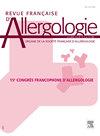类风湿关节炎患者氯喹引起的多形红斑样皮疹:临床表现和处理
IF 0.3
4区 医学
引用次数: 0
摘要
氯喹(chloroquine, CQ)是一种合成的4-氨基喹啉,自1947年问世以来被广泛用于预防和治疗恶性疟原虫疟疾。它的作用机制包括破坏寄生虫对血红素的解毒能力。除了抗疟疾作用外,由于其免疫调节作用,氯喹经常被用于治疗自身免疫性疾病,如类风湿关节炎(RA)和系统性红斑狼疮(SLE)。尽管氯喹因其可负担性和有效性被列入世卫组织基本药物清单,但它与不良反应有关,包括胃肠道紊乱、头痛、皮疹、心脏毒性、视网膜损伤和肝毒性。长期使用也可能导致神经肌肉、神经精神和肾脏并发症,需要仔细监测,特别是在脆弱人群中。病例a: 48岁男性,根据临床和实验室结果诊断为类风湿关节炎,开始服用每日250毫克氯喹,每周5毫克叶酸和扑热息痛以缓解症状。治疗15天后,患者出现进行性红斑疹,伴黄斑丘疹和靶样病变,主要累及手部、前臂和躯干。皮肤活检显示组织病理学特征表明药物引起的超敏反应,包括海绵状病、表皮坏死和血管周围淋巴细胞浸润伴嗜酸性粒细胞。在确认氯喹引起的超敏反应后,停用该药,并给予强的松龙20mg /天和奥美拉唑20mg /天两次治疗。皮疹在开始治疗后几天内消失。结论本病例突出了氯喹罕见但明显的皮肤不良反应,表现为红斑样多形超敏反应。早期识别和及时停用违规药物,加上适当的症状管理,对患者康复至关重要。临床医生必须对这类不良反应保持警惕,特别是对那些因自身免疫性疾病(如类风湿性关节炎)而服用氯喹的患者。本文章由计算机程序翻译,如有差异,请以英文原文为准。
Chloroquine-induced erythema multiforme-like rash in a rheumatoid arthritis patient: A clinicalpresentation and management
Background
Chloroquine (CQ), a synthetic 4-aminoquinoline, has been widely used since its introduction in 1947 for the prevention and treatment of Plasmodium falciparum malaria. Its mechanism of action involves disrupting the parasite's ability to detoxify heme. Beyond its antimalarial role, chloroquine is frequently prescribed for autoimmune disorders such as rheumatoid arthritis (RA) and systemic lupus erythematosus (SLE) due to its immunomodulatory effects. Despite its inclusion in the WHO's List of Essential Medicines for its affordability and efficacy, chloroquine is associated with adverse effects, including gastrointestinal disturbances, headaches, skin rashes, cardiotoxicity, retinal damage, and hepatotoxicity. Long-term use may also result in neuromuscular, neuropsychiatric, and renal complications, requiring careful monitoring, particularly in vulnerable populations.
Case
A 48-year-old male, diagnosed with rheumatoid arthritis based on clinical and laboratory findings, was started on chloroquine 250 mg daily, folic acid 5 mg weekly, and paracetamol for symptom relief. After 15 days of therapy, the patient developed a progressive erythematous rash with maculopapular and targetoid lesions primarily affecting the hands, forearms, and trunk. A skin biopsy revealed histopathological features indicative of a drug-induced hypersensitivity reaction, including spongiosis, epidermal necrosis, and perivascular lymphocytic infiltration with eosinophils. Following the confirmation of a chloroquine-induced hypersensitivity reaction, the drug was discontinued, and the patient was treated with prednisolone 20 mg daily and omeprazole 20 mg twice daily. The rash resolved within days of initiating treatment.
Conclusion
This case highlights a rare but significant dermatological adverse effect of chloroquine, manifesting as an erythema multiforme-like hypersensitivity reaction. Early recognition and prompt discontinuation of the offending agent, coupled with appropriate symptomatic management, are critical to patient recovery. Clinicians must remain vigilant for such adverse reactions, particularly in patients prescribed chloroquine for autoimmune conditions like RA.
求助全文
通过发布文献求助,成功后即可免费获取论文全文。
去求助
来源期刊

Revue Francaise d Allergologie
Medicine-Immunology and Allergy
自引率
33.30%
发文量
349
期刊介绍:
La Revue Française d''Allergologie : un véritable forum pour faire connaître des travaux originaux et permettre la diffusion de l''information auprès de toutes les spécialités concernées par les pathologies allergiques. La Revue Française d''Allergologie (8 numéros par an) est au carrefour de nombreuses spécialités - dermatologie, pédiatrie, ORL, pneumologie, ophtalmologie, médecine interne - qui, toutes, ont à traiter des maladies allergiques. Les symptômes des allergies fondés sur des mécanismes communs sont le plus souvent associés et se succèdent chez un même patient. En forte progression depuis 20 ans, les maladies allergiques sont dans l''attente de perfectionnements et d''avancées thérapeutiques qui permettront aux nombreux patients qui en sont atteints de mieux vivre avec leurs allergies. La Revue Française d''Allergologie se veut donc un véritable forum de discussions et d''échanges entre tous les spécialistes confrontés aux pathologies
 求助内容:
求助内容: 应助结果提醒方式:
应助结果提醒方式:


